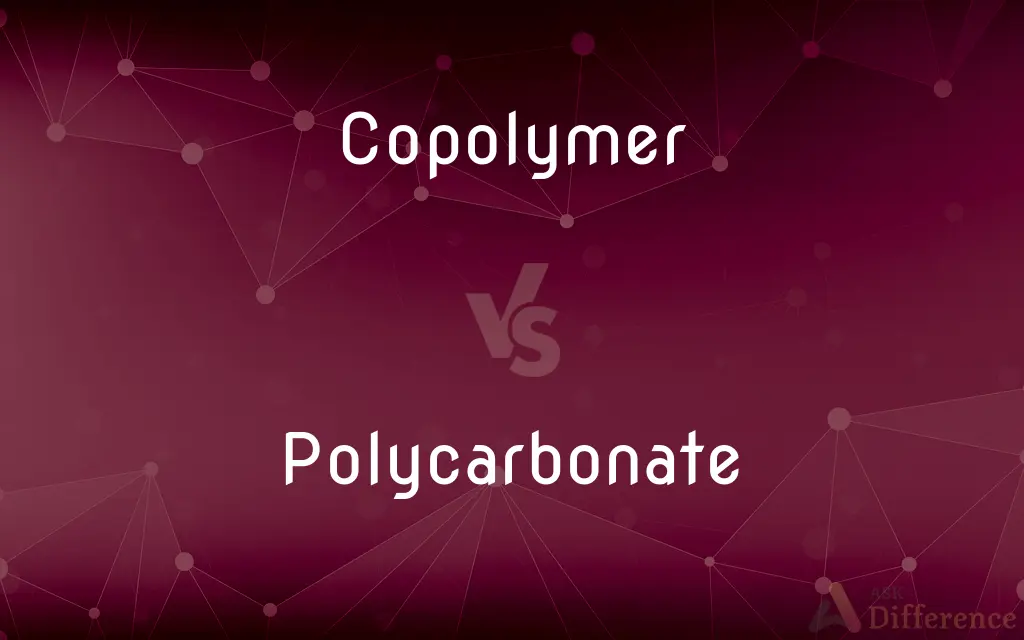Copolymer vs. Polycarbonate — What's the Difference?
By Tayyaba Rehman & Maham Liaqat — Updated on April 2, 2024
Copolymers are polymers made from two or more different monomers, enhancing versatility, while polycarbonates are a specific type of polymer known for their toughness and transparency.

Difference Between Copolymer and Polycarbonate
Table of Contents
ADVERTISEMENT
Key Differences
Copolymers, being composed of two or more types of monomers, offer the ability to tailor material properties such as flexibility, chemical resistance, and temperature resilience. This makes them adaptable for various applications. Polycarbonate, on the other hand, is a specific type of polymer known for its exceptional strength, toughness, and clarity, making it ideal for use in impact-resistant glasses, electronic devices, and automotive components.
The structural diversity of copolymers allows for the creation of materials with specific characteristics by adjusting the type and ratio of monomers used. This results in a wide range of applications, from rubbery materials to hard plastics. Polycarbonate's structure, characterized by carbonate groups within its chains, provides it with high impact resistance and the ability to transmit light almost as well as glass, which is why it's often used in bulletproof windows and eyewear lenses.
Copolymers can exhibit properties not found in homopolymers (polymers made from a single type of monomer), such as improved solubility in solvents or increased mechanical strength, depending on the monomers selected. Polycarbonates are renowned for their ability to withstand temperatures up to about 145°C without deforming and for their excellent electrical insulation properties, which is why they are preferred in electrical and electronic applications.
In terms of environmental considerations, copolymers' adaptability allows for the design of materials that can be more easily recycled or that degrade more readily in the environment, depending on the choice of monomers. Polycarbonate, while recyclable, has raised environmental concerns due to its production involving bisphenol A (BPA), a compound associated with health risks, leading to the development of BPA-free polycarbonates and alternative materials.
Comparison Chart
Composition
Made from two or more different monomers
Made from bisphenol A and phosgene
ADVERTISEMENT
Key Properties
Tailorable flexibility, chemical resistance
High strength, toughness, and optical clarity
Applications
Varied, including automotive parts, packaging
Bulletproof windows, eyewear, electronic components
Temperature Resistance
Depends on monomers used
High, up to about 145°C
Environmental Impact
Can be designed for better recyclability or degradation
Recyclable, but concerns over BPA content
Compare with Definitions
Copolymer
A polymer derived from more than one species of monomer.
Nitrile rubber is a copolymer of butadiene and acrylonitrile used in gloves.
Polycarbonate
A thermoplastic polymer known for its toughness and clarity.
Polycarbonate panels are used in greenhouse constructions for their durability and light transmission.
Copolymer
Used to enhance mechanical or chemical properties.
Acrylonitrile butadiene styrene (ABS) is a copolymer known for its toughness in automotive components.
Polycarbonate
Contains carbonate groups in its molecular chains.
Compact discs are made of polycarbonate for its optical clarity and durability.
Copolymer
Exhibits properties unlike homopolymers.
Ethylene-vinyl acetate copolymers offer clear, flexible packaging films.
Polycarbonate
Resistant to impact, temperature, and electrical insulation.
Safety helmets are often made from polycarbonate due to its impact resistance.
Copolymer
Can be tailored for environmental degradation.
Biodegradable copolymers are used in medical devices that dissolve in the body.
Polycarbonate
Can be produced without BPA for health safety.
BPA-free polycarbonate water bottles are popular for their safety and clarity.
Copolymer
Material with adjustable properties for specific applications.
Styrene-butadiene copolymer serves as a versatile synthetic rubber.
Polycarbonate
Utilized in medical devices for its sterilization capabilities.
Polycarbonate syringes are used for their strength and clarity.
Copolymer
A copolymer is a polymer derived from more than one species of monomer. The polymerization of monomers into copolymers is called copolymerization.
Polycarbonate
Polycarbonates (PC) are a group of thermoplastic polymers containing carbonate groups in their chemical structures. Polycarbonates used in engineering are strong, tough materials, and some grades are optically transparent.
Copolymer
A polymer of two or more different monomers.
Polycarbonate
Any of a group of thermoplastics that are linear polyesters of carbonic acid, especially those derived from bisphenol A and phosgene, characterized by high-impact strength, light weight, and flexibility, and used as shatter-resistant substitutes for glass.
Copolymer
(chemistry) A polymer derived from more than one species of monomer.
Polycarbonate
(chemistry) Any of a range of polymers of aromatic carbonates; they are used to make light, flexible alternatives to glass. Abbreviation: PC
Copolymer
A polymer consisting of two or more different monomers
Common Curiosities
Do all copolymers contain BPA?
No, not all copolymers contain BPA; the presence of BPA depends on the specific monomers used in the copolymerization process.
Can polycarbonate be used in food containers?
Yes, polycarbonate can be used in food containers, especially BPA-free variants, due to its clarity and toughness.
Is polycarbonate environmentally friendly?
While polycarbonate is recyclable, its environmental friendliness is debated due to concerns over BPA. However, BPA-free and recycled polycarbonate options offer more eco-friendly alternatives.
Can the properties of copolymers be predicted?
The properties of copolymers can often be predicted based on the monomers used and their ratio, but practical testing is usually required to confirm these properties.
What are the safety considerations when using polycarbonate?
Safety considerations include avoiding exposure to BPA for certain types of polycarbonate and ensuring the material is used within its temperature limits to prevent degradation.
How are copolymers synthesized?
Copolymers are synthesized through various polymerization methods, such as chain-growth or step-growth polymerization, involving two or more different monomers.
Why is polycarbonate used in bulletproof glass?
Polycarbonate is used in bulletproof glass due to its high impact resistance and ability to absorb energy without breaking.
Can polycarbonate withstand outdoor conditions?
Yes, polycarbonate can withstand outdoor conditions, including exposure to sunlight, temperature variations, and physical impacts, making it ideal for outdoor applications.
What makes a copolymer different from a homopolymer?
A copolymer is made from two or more different monomers, offering tailored properties, while a homopolymer consists of only one type of monomer.
Are copolymers recyclable?
Copolymers can be recyclable, depending on their specific composition and the recycling facilities available.
Share Your Discovery

Previous Comparison
Atrophy vs. Hypotrophy
Next Comparison
Spread vs. MarginAuthor Spotlight
Written by
Tayyaba RehmanTayyaba Rehman is a distinguished writer, currently serving as a primary contributor to askdifference.com. As a researcher in semantics and etymology, Tayyaba's passion for the complexity of languages and their distinctions has found a perfect home on the platform. Tayyaba delves into the intricacies of language, distinguishing between commonly confused words and phrases, thereby providing clarity for readers worldwide.
Co-written by
Maham Liaqat















































